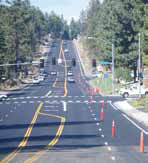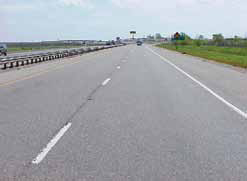U.S. Department of Transportation
Federal Highway Administration
1200 New Jersey Avenue, SE
Washington, DC 20590
202-366-4000
Federal Highway Administration Research and Technology
Coordinating, Developing, and Delivering Highway Transportation Innovations
 |
| This report is an archived publication and may contain dated technical, contact, and link information |
|
Publication Number: FHWA-HRT-10-071 Date: August 2010 |
"The AASHTO MEPDG is based on engineering mechanics principles as much as possible. However, the heart of the design procedure is key distress and smoothness prediction models that required calibration with measured performance data. The LTPP database provided such long-term performance data for hundreds of asphalt, concrete, and rehabilitated pavement sections that were used in the national calibration. Without LTPP data for the national calibration, the MEPDG distress models could not have been validated for use throughout the country. In addition, LTPP data is invaluable to each State highway agency for its own local validation and calibration purposes."
M. I. Darter, Ph.D.
Applied Research Associates, Inc.
An original LTPP objective was to acquire data for use in evaluating existing design methods and in developing new ones. The program has achieved this objective. LTPP data have been used in numerous studies tasked with evaluating or developing design procedures, the most recent being the Mechanistic-Empirical Pavement Design Guide (MEPDG). The LTPP program has also supported the implementation of, and advancements in, pavement management systems for agencies throughout the country.
Since the late 1990s, one of the pavement research community's single largest investments has been in the development of the MEPDG. Development of the new guide required detailed information about pavements located across the country and representing a wide range of loading, climate, and subgrade conditions with varying structural compositions. The LTPP database was critical to the development of the MEPDG, as it is the only source of comprehensive pavement data representative of national conditions. In fact, the MEPDG could not have been completed without the type and national extent of data provided by the LTPP studies. All of the traffic loading defaults provided in the MEPDG, for example, were derived from the LTPP traffic database using WIM sites across the United States and Canada, and all of the distress and smoothness models in the MEPDG were calibrated using LTPP data.
The MEPDG models evaluate the impact of traffic, climate, materials, and subgrade stiffness on performance and account for the interactions among these components. The MEPDG predicts individual performance measures (i.e., transverse cracking, fatigue, smoothness, rutting) based on site condition input for a given trial pavement section. These prediction techniques can be used in pavement evaluation studies, as well as in forensic investigations.
MEDPG Development
National Cooperative Highway Research Program (NCHRP) Project 1-37A (Development of the 2002 Guide for the Design of New and Rehabilitated Pavement Structures: Phase II) was undertaken to develop a new pavement design guide based on mechanistic-empirical relationships and utilizing accepted and proven technologies. The new guide was developed to address the many limitations of the existing design procedure, which was based on data collected at the American Association of State Highway Officials (AASHO) Road Test in Illinois in the late 1950s. That design procedure has served the industry well, but has deficiencies due to some of the limitations of the AASHO Road Test:
Local Calibration
The LTPP database is serving as a critical tool in implementing the new design guide. The MEPDG was delivered with the prediction models calibrated to average national conditions. For the guide to be an effective resource for individual agencies, the national models need to be evaluated against local and regional performance. The results of these evaluations are being used to determine if local calibration is required. In addition, LTPP sites provide typical values for many of the MEPDG inputs.
Additional studies have been initiated as a direct result of the MEPDG. NCHRP 1-40A (Independent Review of the Recommended Mechanistic-Empirical Design Guide and Software) investigated the assumptions, evaluated the reasonableness and reliability, and assessed the implementation opportunities of the new design procedure.
The objectives of the NCHRP 1-40B project (Local Calibration Guidance for the Recommended Guide for Mechanistic-Empirical Design of New and Rehabilitated Pavement Structures) were to develop a user guide and a manual on local calibration of the MEPDG. Local validation and calibration will rely heavily on the LTPP database as many agencies do not otherwise have the data necessary to complete this endeavor.
Sensitivity Studies of Models
Data from the LTPP SPS-5 project in New Jersey have been used to study the sensitivity of the MEPDG to weather and traffic inputs.14 The initial analysis compared the predicted outputs of the Enhanced Integrated Climatic Model for Pavement Design and found that the predicted moisture content for unbound material and temperature profiles of bound layers were significantly different from those measured on the SPS-5 project. These differences prompted additional research on the sensitivity of the MEPDG performance predictions using climatic inputs from different weather stations.
This study stands as a testament to the critical role LTPP data will play in evaluating, calibrating, and validating the MEPDG on a local level. The results indicate that the MEPDG will need to be refined for use in New Jersey's conditions, and the refinement process will likely rely heavily on LTPP data.
Other studies are being performed in support of the MEPDG at the State and national levels. One example is NCHRP 1-42A (Models for Predicting Top-Down Cracking of Hot-Mix Asphalt Layers), which is investigating models to predict top-down cracking, a damage function included in the MEPDG as a placeholder for this observed but not fully understood distress. The LTPP SPS-1 projects will serve as an excellent resource for studying the effect of pavement thickness in the development of top-down versus bottom-up cracking. Forensic analysis of the SPS-1 projects can provide valuable information on the factors influencing the origins of top-down cracking.
Understanding how design methods relate to actual performance is extremely valuable. Design procedures can be modified based on research findings, and better decisions on design policy can be made.
AASHTO Rigid Pavement Design Spreadsheet
A study was undertaken to make improvements to the 1993 AASHTO Rigid Pavement Design Guide. The improvements included enhanced k-value selection techniques, curling and warping considerations, guidance on joint spacing, inclusion of slab/base friction, and new performance prediction capabilities.
These advancements led to more cost-effective and reliable pavement designs. The research utilized LTPP data to conduct the most critical portion of the study—validation of the new methodologies. Based on the findings, AASHTO adopted the new techniques as part of the 1998 Supplement to the AASHTO Guide for Design of Pavement Structures.
In addition, the LTPP program sponsored the development of a software application to automate the new and improved design process. Not only does the software incorporate all of the new features of the Rigid Pavement Design Guide, it can also perform sensitivity analyses. This capability has contributed to improved pavement designs as engineers have better information regarding the effects of variability in design inputs. The software has been Web-enabled—LTPP Pavement Online—and is available through the LTPP Products Online Web site, free of charge (see figure 3).
Continuously Reinforced Concrete Pavement Performance Study
The LTPP GPS-5 experiment provides performance, design, climatic, and traffic information for 85 continuously reinforced concrete pavement (CRCP) test sections located in 29 States across the country.15 This information was used to study CRCP performance and to identify the characteristics of sections that are performing well.
Using the September 1999 LTPP database, inventory and performance information was used to evaluate CRCP test sections. High-severity transverse cracking, average crack spacing, total punchouts and patches (i.e., localized failures), and smoothness were of particular interest to the researchers. This information was beneficial in evaluating current CRCP design practices as well as understanding key design factors in performance.
Further analysis was conducted to evaluate the characteristics of the GPS-5 test sections that were performing extremely well. Pavements that were 20 or more years old and that exhibited an International Roughness Index measurement of less than 1.5 m/km, no localized failures, and no high-severity transverse cracks were defined as excellent performers. Of the 85 GPS-5 test sections, 13 fell into this category.
The results from this study are useful to pavement designers, materials engineers, and others who make the critical choices that will determine level of service and return on investment when building CRCP pavements. The data available through LTPP will continue to provide a means of evaluating pavement performance to enhance design, construction, and maintenance activities. These analyses will lead to improved performance at reduced overall cost.
LTPP and the Texas Flexible Pavement DatabasePavement data from the LTPP program were essential to the development of the MEPDG. Now those same data are proving critical to the development of local and regional pavement design models. Calibrated for national standards, the MEPDG models cannot be assumed to apply to specific locales—researchers have noted that in some cases the software produces unreasonable results, partly due to regional differences in soil, construction materials and practices, climate, and traffic loads. Recognizing the need for data that can be used to develop, validate, and calibrate flexible pavement design models, the Texas DOT (TxDOT) recently sponsored a 3-year project at the University of Texas at Austin to develop and deploy a flexible pavement database, with two objectives:
A major challenge for the project researchers was to design a database of sufficient size and complexity to fulfill pavement design needs—yet not so large or complex as to be too burdensome to maintain. The project resulted in the online Texas Flexible Pavements Database with pavement sections spanning the climate, traffic, and structure types found in Texas. LTPP data were critical to the development of the database, providing the long-term performance data necessary for initial calibration. Of the 86 pavement sections housed, 45 are LTPP sections in Texas. Each has information on traffic, materials, structure, and performance history. The other 41 sections are relatively new sections recommended by TxDOT. When sufficient performance data have been collected on the newer sections, they will become the primary data source for validation and calibration of pavement design and performance models. "The database is delivering what it was designed for. There is no doubt that the interim calibration factors recommended by this study are more accurate for predicting pavement performance in Texas than the default national values," says Jorge Prozzi, the principal investigator. "The database will evolve over time. We recommend that Texas continue to monitor these sections annually for at least the next 10 years, and add new sections as newer materials like recycled asphalt and warm-mix asphalt come into wider use in the State. New sections with thin asphalt surfaces and surface treatments should also be added." The procedures followed and the calibration factors determined in the calibration methodologies—one for calibration of mechanistic rutting models and the second for empirical roughness models—are available in the project's final report, Development of the Texas Flexible Pavements Database, available at www.utexas.edu/research/ctr/pdf_reports/0_5513_2.pdf. |
FIGURE 3. Screen capture of LTPP Pavement Online—Rigid Pavement Design software.
Using the models developed as part of pooled fund study TPF-5(013), Effect of Multiple Freeze–Thaw Versus Deep Frost Penetration on Pavement Performance (Final Report, FHWA-HRT-06-121), a software application, LTPP Performance Forecast Online, was developed that provides pavement performance predictions (i.e., smoothness and distress) for both flexible and rigid pavements. Each of the models provided in the Performance Forecast application incorporated data from LTPP test sections and is completely described and documented in the report. The predictions/forecasts are based on user-defined inputs for environment, traffic, structure, and subgrade conditions.
|
"Indeed, LTPP is providing one of the most important elements in technology development through field validation and calibration. The use of LTPP data helps demonstrate to the user community that the models and technologies being developed really match realworld problems." M. W. Witczak, Ph.D. Professor of Civil Engineering, Arizona State University |
The online application (www.ltpp-products.com/Predictor/index.aspx) can be used by State, county, and local highway agencies to forecast or estimate performance trends for pavement sections within their jurisdictions. These estimates are useful in evaluating the prediction capabilities of the MEPDG to determine whether local calibration is necessary for the validation and implementation process. The predictions are also beneficial in updating pavement family performance curves within pavement management systems, allowing decision makers to optimize investment choices and improve overall pavement network conditions.
Traffic loading and environmental conditions are the two major causes of pavement deterioration. Therefore, accurately capturing both elements—as done in the LTPP program—is paramount in analyzing pavement performance. Other critical elements in pavement performance include the materials used in the bound and unbound layers, as well as the selection and timing of preventive maintenance activities.
Pavement engineers consider many alternatives when designing a pavement system. The LTPP database has been used to sort out these alternatives and establish optimal design features for use in certain situations. The data has also been used to change design policy at State and local agencies.
An extensive study, LTPP Data Analysis: Influence of Design and Construction Features on the Response and Performance of New Flexible and Rigid Pavements, was conducted under NCHRP16 on all SPS-1, SPS-2, and SPS-8 projects to evaluate the influence of site conditions and design factors on pavement response and performance. SPS-1 projects consist of multiple flexible pavement test sections constructed consecutively with various layer thicknesses, base types, base thicknesses, and drainage configurations. Similarly, test sections on an SPS-2 project are composed of various slab thicknesses of the PCC, base type, PCC flexural strength, drainage, and lane width combinations. Both of these projects provide an excellent source of data to evaluate the effectiveness of various design features and the impact of in situ conditions. The SPS-8 experiment was designed to study the influence of environment in the absence of heavy loading.
This study can be used by those interested in the contribution of design factors on flexible and rigid pavement performance. The present benefit of this study is an understanding of the interaction between design parameters and climate and the resultant changes in pavement performance. The LTPP database provides a means of conducting this type of study on a national scale. The findings from this study can be used to optimize cost-effective design alternatives and will be useful in transferring mechanistic evaluations to field performance for various design parameters.
Before the LTPP program, there was limited information on the performance of rehabilitation and maintenance activities. The experimental design of the LTPP database ensured that information on maintenance and rehabilitation strategies and their deterioration rates was collected (SPS-3 and SPS-4 maintenance studies; SPS-5 and SPS-6 rehabilitation projects; GPS-6 and GPS-7 asphalt concrete overlay sections). Thus the database provides performance data for various maintenance and rehabilitation alternatives.
Some of the LTPP experiments offer side-by-side comparisons of treatment alternatives that allow direct comparison while keeping selected factors (such as subgrade, traffic, and climate) constant. The results can be used to determine the most cost-effective treatments based on life cycle cost analysis. These experiments can also be used to predict the expected service life of treatments based on in situ conditions. By knowing the expected life, pavement management engineers can develop proper timing intervals and determine budgetary needs.
As part of the LTPP data analysis program, an NCHRP study, LTPP Data Analysis: Effectiveness of Maintenance and Rehabilitation Options,17 evaluated the performance of various maintenance and rehabilitation strategies on immediate improvements in pavement condition, as well as their long-term effects. In addition, the impact of climate, traffic, and pre-treatment pavement condition were analyzed. For flexible pavements, both maintenance and rehabilitation strategies were studied; for rigid pavements, only rehabilitation strategies were considered. Data from LTPP SPS-3, SPS-5, SPS-6, GPS-6B, and GPS-7B experiments were utilized in the NCHRP study. The findings from this study can be used to understand the impact of maintenance and rehabilitation treatments. With this understanding, engineers can make informed decisions on treatment types based on the existing condition of the pavement, expected traffic, and climate. Findings such as these are very useful to pavement decision makers in evaluating the cost effectiveness of alternative strategies, materials, and methods.
 LTPP experiments have contributed to more costeffective pavement preservation strategies. |
 |
 Above: A pavement test section with a 2-in. recycled asphalt overlay. Left: LTPP rehabilitation experiments included jointed concrete pavements. |
Use of Reclaimed Asphalt Pavement
The growing demand for materials to rehabilitate the highway infrastructure in the United States and the increasing need for sustainable and environment-friendly alternatives have substantially increased the demand for recycling materials. The most common application of material recycling in pavements is RAP, reclaimed asphalt pavement.
Research was done under LTPP SPS-5 to determine the effects of design and construction features on pavement response and performance and to establish their importance in predicting the future performance of rehabilitated pavements. The performance data from LTPP SPS-5 revealed that RAP and virgin hot-mix asphalt mixes used in overlays of flexible pavements show approximately the same performance across a wide range of climates, traffic, and existing pavement conditions over a service life ranging up to 17 years.18 The evaluation of the deflection data suggested that when thick overlays are designed for pavement sections, the likelihood that the performance will be similar for both types of mixes increases. This major finding should give agencies confidence in specifying RAP mixtures for overlays when economic and other conditions warrant.
Materials Reference Library
|
||||||
FHWA-HRT-10-071